One of the smallest passerines in North America, are the bushtits (psaltriparus minimus). Passerines are any birds that come from the scientific order Passeriformes. These birds are also the only species of its kind to live in Canada and even in British Columbia. They are one of the most social birds that you’ll ever come across and are usually found amongst 10-40 (The Cornell…c2015) other bushtits. But they are so small, only weighing about 4-6g (The Cornell…c2015), that you’ll only notice them when they all start flying out of a tree. Luckily you won’t miss the chance to see these little birds as they often do not migrate and like to stay in the same areas all year round.
These birds have nothing special about their colours but they do come across as cute puff balls! It is hard to differentiate feather colour between male and female bushtits, as they are plain, gray-drab birds with a long tail and a short beak. But an obvious difference between male and female is that males have a dark eye while females have a yellow iris around the pupil. An interesting fact is that bushtits have slightly different colouration depending on the geography. If you see them in the south such as New Mexico, the male bushtits there appear to have black feathers around the ears and eyes (McKnight, 1969).
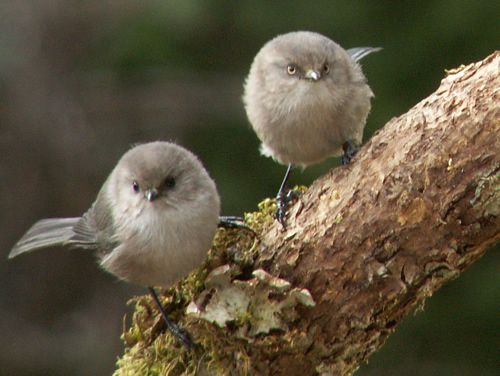
A male bushtit to the left with a dark eye and a female bushtit to the right with a yellow iris. [link]
Bushtits have a large breeding distribution range, they are found in the Pacific Coast of British Columbia and the entire Rocky Mountain chain, all the way down to central America along the coastline and the United States interior (Packert et el, 2010). They live in well diverse habitats, from lowlands of wooded or brushy areas such as oak scrubs, mixed woods, and junipers to middle elevations in the mountains of pine-oak woods, oak forest, and well-wooded suburbs (Audubon, 2017). Because of their wide spread distributions, Bushtits are not lacking in numbers and we can safely say that we do not have to worry about their endangerment (Audubon, 2017).
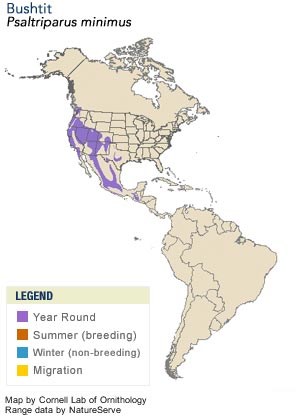
A map of where bushtits are found. From the west coast of British Columbia and the Rockies all the way down to Central America. [link] And a dynamic view of the map. [link]
But besides trying to find these tiny birds amidst the scrubs and hidden in between leaves, if you listen hard enough you should be able to hear the chatters of a flock communicating to each other. They chip in a faint one-syllabled simple note and are usually in irregular successions (tsit, tsit; tsit; tsit). (Grinnell, 1903) They talk when they are foraging for small insects and spiders. Bushtits will eat any small insects from beetle, caterpillars, and ants to very tiny insects that adhere to leaves and twigs (The Cornell…c2015). There are sometime stragglers that have trouble catching up to the main flock, so they will start chipping to each other as an indication of their whereabouts. When predators are near they will all start uttering sharp alarm notes (scre-e-e-e-e-e, etc) (Grinnell, 1903) to warn each other until everyone is in unison. This confuses their predators because the bushtits are scattered in all shrubs and trees so it is hard for the predator to locate a single bird.
A bushtit’s call [link]
One of the most unique thing about bushtits are their nests. It is not the typical nest that you see other birds make with twigs and branches, these are hanging nests. That’s right, these nests are built a foot below an overhanging branch and constructed from mosses, lichen, oak leaves, and spider webs that help blend with their surroundings (Addicott, 1938). The inside is insulated with materials such as feathers, fur and downy plant matter (The Cornell…c2017). And the nest itself is like a long pendant bag and entrance to the nest consists of a hole at the top and above it is the hood to cover it (Addicott, 1938). It takes these little birds a considerable amount of time and energy to make these nests just so they can lay their eggs. The shortest time recorded was 13 days and the longest went up to 51 days (Addicott, 1938). And they will lay about 4-10 clutches a nest. These nests are reusable for the second year of breeding or other pairs of bushtits can claim abandoned nests as well.
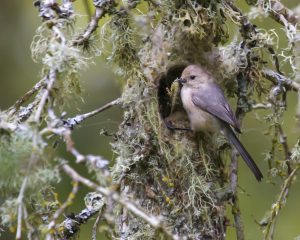
A male bushtit perched at the front entrance of its nest. [Link]
Bushtits may not have the most vibrant colours nor do they have crazy features, eg; a steller’s jay fohawk or a peacock’s tail but I’m sure their name itself caught your attention. Fun fact, tit comes from their scientific name Psaltriparus minimus, which Psaltriparus, “parus”, is Latin for titmouse. And “tit” originates from Old Icelandic word “titr” meaning something small. (Kraft, 2009) Keep an eye out on my next blog post about some scientific research I found on these cuties!
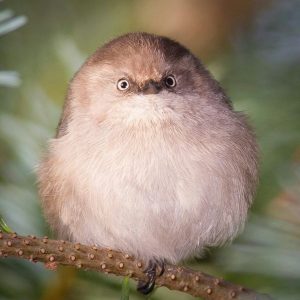
This female bushtit is telling you to go read the next blog post! [Link]
Literature Cited
Addicott A. 1938. Behavior of the Bush-Tit in the Breeding Season. The Condor. 40(2): 49-63. [Link]
Audubon: Guide to North American Birds. c2017. New York: National Auduborn Society; [accessed 2017 October 4]. [Link]
Grinnell J. 1903. Call Notes of the Bush-Tit. The Condor. 5(4): 85-87. [Link]
Kraft C. 2009 October 7. Bushtit: long-tailed tits are birds, seriously [blog]. Wild Things & other earthly concerns. [accessed 2017 October 4]. [Link]
McKnight, CB. 1969. Change in Facial Coloration in a Bushtit. The Auk. 86(3): 570. [Link]
Packert M, Martens J, Sun Y. 2010. Phylogeny of long-tailed tits and allies inferred from mitochondrial and nuclear markers (Aves: Passeriformes, Aegithalidae). Elsevier. 55(3): 952-967. [Link]
The Cornell Lab of Ornithology: All About Birds. c2015. Ithaca, NY: Cornell University; [accessed 2017 October 4]. [Link]
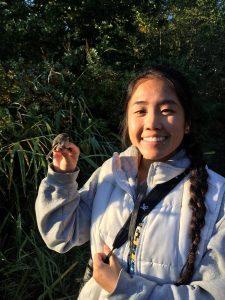
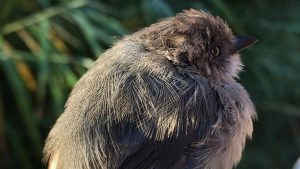
Wow! The Bushtit seems fascinating and your post was very informative. I was wondering if you know of any advantages there are to the nests the bushtit’s build as compared to more standard nests?
Good question! I think that bushtit’s build these kind of nests for the extra heavy insulation since they are more vulnerable to cold. Especially if pairs can have up to 10 eggs they would need some kind of way to get extra warmth to cope with the cold nights. Also they cover the outside of the nest with leaves, plant material and anything from their surroundings as a way of camouflaging from predators.
Interesting! I think nest reuse isn’t too common because it tends to break down fairly quickly. Our neighbours had a nest, but not too long after the young fledged, it broke apart and fell off. Super fun to watch them go in and out.
Great post! There are some bushtit nests at Buttertubs Marsh – I had no idea that’s what they were though.
Do you think there’s a connection with the females having yellow eyes and the females having a ‘W’ Chromosome, whereas the males are ‘ZZ’ and exclusively have black eyes?
What!! You need to show me these nests cause I haven’t seen any in person! That’s so cool hahah. That’s a really good question but unfortunately I’m not sure about the answer. I think that these are the only birds to have two different eye colours to differentiate between sexes, but i’ll try to get back to you on that! 🙂
This was short and informative, a very pleasant read. Thank you for sharing what you learned and I hope you get more opportunities to approach other species of birds. Your analysis was fun to read and kept my attention, good luck with your future posts!
Excellent title by the way.
Thank you for the comment! If you follow our class’s website http://wordpress.viu.ca/biol325/ there will be a lot more blog posts from other students coming up!
Great blog post! I had no idea the Bushtit’s nest was created in such a way. You mentioned how bushtits can lay anywhere from 4 to 10 eggs per nest. Do you know how many of these birds tend to survive? i.e. What the survivability rate of bushtits are? It is hard to imagine that all nestlings would survive in a 10 egg clutch.
Overall, it was an enjoyable read 🙂
Thanks! I know right, it so big for such a tiny bird haha. Unfortunately I couldn’t find any specific numbers on the survivability rates but many fledglings tend to survive form the help of supernumeraries. In other words, helpers, or unmated males (in most case), help feed the offsrpings and can tend to them until they become independent.
An interesting fact I found out was the large number of clutch could be due to two females attending a single nest and both laying eggs.
That’s fascinating about helping behaviour. They must have an interesting social structure because when we catch big flocks at Btubs, it’s not uncommon to catch way more of one sex or of one age group. Would be neat to look more into this.
Great article! I am incredibly impressed with the amount of little details you included in your article. I think I might want to go out and find some “tits” myself lol. How big can bushtits grow up to and what is their current conservation status?
Well they can get up to 8 cm and their conservation status is not a risk. Their population is stable with a slight decline within the past few years.